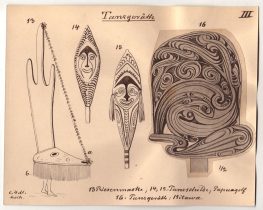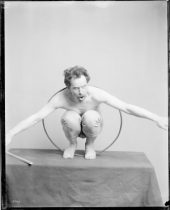If you ask someone today if they have ever heard of the American Museum of Natural History (AMNH) they will say one of three things. The younger generation will think of the popular movie starring Ben Still called Night at the Museum. In fact, this movie makes history come alive for children as Stiller’s character interacts with all the exhibits, which come to life at night. As you can imagine some of them cause a lot of drama, especially the ones involving animals. This movie is what opened the imagination of so many children and made the want to go to museums. If you ask scholars about the AMNH, they will mention the Margret Mead Film Festival. This festival shows the up and coming documentaries that dig deep into different human cultures. In a sense they are video ethnographies. Other people will know it for it wide range of exhibits and it’s dedication to education.
The AMNH has a very long history. In 1869, a student of of Harvad zoologist Louis Agaassiz, Albert Smith Bickmore won the support of William E. Dodge Jr., Theodore Roosevelt SR., Joseph Chiate and J. Pierpont Morgan for his proposal to create a natural history museum in New York City. Also in that year, the Act of Incorporation is signed by Governor John Thompson Hoffman on April 6th, officially creating the American Museum of Natural History and John David Wolf is made its President.[1] In, 1871, the ANMH displayed its first collection at Central Park Arsenal.[2] The museum then ran into a huge problem. The collection was quickly growing beyond the capabilities of the museum. So they started construction at its current address at Central Park West at 79th street. During the 19th century a building’s cornerstone was a very big deal. It was the stone which all other stones were built off of. Many buildings and institutions would often hold a special ceremony for the laying of this stone. The AMNH is no different. On June 11, 1874 the Christian Advocate in Chicago published an article about it:
“On Tuesday afternoon of last week the corner-stone of the American Museum of Natural History was laid at Manhattan Square, in this city, in the presence of…President Grant, Secretaries Fish and Robeson and a large number of prominent citizens. After a prayer by Rev. Dr. Stephen H. Tyng Sen…. Professor Albert S. Bickmore read a list of coins, documents, etc., in the box placed beneath the corner-stone, which was then laid by President Grant with a silver trowel”[3]
This except from the article proves just how important this museum was. The President of the United States came and participated in the ceremony. The President only went to ceremonies that would have a large effect on the country. The mention of a prayer emphasizes the country’s history of a Christian connection. This was time were church and state did not have such strict boundaries. It was common for all events and ceremonies to have a prayer said at them.
In 1881, the new Museum President Morris K. Jesup is appointed and he launches the museum into an age exploration. Over the course of the next two decades the Museum took representatives all over the globe during expeditions which explored and discovered parts of Siberia, the North Pole, Outer Mongolia, the great Gobi and the jungles of the Congo.[4] All of these expeditions brought back many interesting objects. The first expedition they become a part of in the Finisch Pacific Expeditions.
The expeditions were from 1879-1885. Finisch collected over 1,000 objects from about a dozen Pacific islands and brought

them to the AMNH. Figure 1, is one of the hundreds of illustrations made during the expedition. It demonstrates the process of accessioning objects into a museum. This was a time that the process of photography was a very long. Also to transport all of the chemicals and substances was very dangerous and difficult. The chemicals were very flammable so traveling could take longer to ensure the safety of the people and the safety of the film itself. Therefore, in the figure we see the objects drawn rather than photographed. This drawing also shows a large shift in New York society as a whole. All of the writing on the images are German and that showed that Otto Finsch was German. In the past, like most immigrants, Germans were seen as bad, dirty and unintelligent. They lived in the poorest neighborhoods, like the five points, and did not have the best jobs. This is was a time where impressions of Germans changed. Not only were they getting an education but also, they were looked upon as very intelligent. Previously, the AMNH never would not have sponsored an expedition led by a German. The new opportunities and education given to the Germans enabled the museum to do so. This also suggested that the German population were getting better jobs and living in better neighborhoods.

The museum had begun to get so many objects that they started to separate them. They created one area called the Hall of Northwest Indians was opened on the first floor in 1896. This also sparked one of the biggest expeditions solely sponsored by the museum. The Jesup North Pacific Expedition, organized by Franz Boas, during 1897–1902.[5] This expedition changed not only the museum but also, the study of anthropology. This was the first exhibit which focused on a new culture in a positive light. A person noted,
“[Boas] began to illustrate the life-styles of the Indian tribes that he had studied… and he attempted to reconstruct the history and migration patterns of the various tribes by careful arrangement of the artifacts in the museum’s possession.” [6]
Boas even posed for pictures to make sure that all of the objects were set up correctly. As you can see in figure 2, this was one of Boas standard practices while setting up an exhibition. In turn his standards, started new ones in Anthropology and in other museums.
A shift in schooling starts to happen during this time; the “class field trip” emerged. Originally, museums were for the elite to take their families to because they were the only ones who could afford to get to them. Now you could see that museums were letting schools bring entire classes in at once, such the class in figure 3. This photograph was a part of a series which showed different classes and types of children at the museum. You could see disabled children, like the blind. As well as, all boys and all girls. The photograph shows a class with both. This suggests that schools are starting to be co-ed when previously they were gender separate. However you still saw norms continuing. All of the children were very well dressed and most had expensive coats, so you could infer that they were wealthy. School was still majorly for the wealthy white.

The next set of exhibits shifted the museums to offer bigger, better and more objects for people to study. In 1930, the AMNH opened up the first major hall of mammal habitat dioramas, called the South Asiatic Hall. This hall displayed the gifts from an expedition led by Arthur S. Vernay and Colonel J.C. Faunthorpe. Three years later the Hall of Oceans life opened. In 1936 the Theodore Roosevelt Memorial Hall and it’s Rotunda opened.[7] This was a very interesting exhibit because it only was honoring former President Roosevelt. It suggests that the country, or at least New York City, thought that he was the last great President. It is also surprising that they were able to open the exhibit because they were going through the Great Depression at the time. Perhaps they were able to because they may have gotten the money, to hire people, from the New Deal.
In 1942 the Hall of North American Mammals open. In 1957 the Hall of North American Forests opens. In 1960, the Great Canoe exhibit is installed near the 77th Street entrance.[8] From 1963-1998 you have a large amount of construction and creating on new halls. This includes, North American Small Mammals, Primates, Eastern Woodlands, Plain Indians, African Peoples, Mexico and Central America, Reptiles and Amphibians and many more.[9] This tradition has continued until the present.
What makes the exhibits so emphasized is the intense study done on them. One journal called “A brief history of geomagnetism and a catalog of the collections of the National Museum of American History” by Robert P Multhauf and Gregory Good, takes there readers through the exhibition and helps them along it. They explain,
“as in any science, the terms used in geomagnetism have changed over time. Typically, the number of technical terms tends to increase until a movement towards simplification of the science combines and reduces them, after which further development again results in a proliferation of technical terms. Historical writers cannot ignore this, but can at least offer some guidance into the terminological jungle.”[10]
They then teach the reader about the old terms and what they are referred to in modern times. It was journals like these who helped people have a deeper understanding of a particular exhibit.
Today you can see all of the wonderful exhibits. Franz Boas exhibit is actually still in its original form. It has not be renovated once. It makes you feel like you are in a part of history. An amazing event that takes place every year is the Margret Mead Film Festival. It shows documentaries about all different cultures. Tickets are pretty reasonably priced, about $12 per film. That’s cheaper than going to a movie theater. There are even special passes and student discounts to sweeten the deal. It happens every fall around October or November. At the end of each film there is a questions and answers session with the film’s creator and/or subjects. It really gives you the chance to try to deeply understand someone else’s life.
The American Museum of Natural History is an amazing place. It is where you can connect history to the present with just a blink of the eye. It is one of the most popular tourist attractions and a place where everyone should go at least once. It has also been a great reflection of New York City throughout the years and has changed with it.
[1]“History 1869-1900.” AMNH. Accessed October 03, 2017. https://www.amnh.org/about-the-museum/history/history-1869-1900
[2] Ibid.
[3] American museum of natural history. (1874, Jun 11). Christian Advocate (1866-1905), 49, 189. Retrieved from https://search-proquest-com.ezproxy.shu.edu/docview/125921634?accountid=13793
[4] “History 1869-1900.” AMNH. Accessed October 03, 2017. https://www.amnh.org/about-the-museum/history/history-1869-1900
[5] “History 1869-1900.” AMNH. Accessed October 03, 2017. https://www.amnh.org/about-the-museum/history/history-1869-1900
[6] Cole, Douglas. 1999. Franz Boas: the early years, 1858-1906. Vancouver: Douglas & McIntyre.
[7] “History 1901-1960.” AMNH. Accessed November 14, 2017. https://www.amnh.org/about-the-museum/history/history-1901-1960.
[8] Ibid.
[9] “History 1961-1990.” AMNH. Accessed November 14, 2017. https://www.amnh.org/about-the-museum/history/history-1961-1990
[10] Multhauf, Robert P., and Gregory Good. 1987. A brief history of geomagnetism and a catalog of the collections of the National Museum of American History. Washington, D.C.: Smithsonian Institution Press.